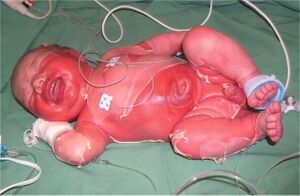Staphylococcal scalded skin syndrome
Staphylococcal scalded skin syndrome (SSSS) is caused by Staphylococcus aureus toxin. It affects newborns and young children, and is rare in older children and adults.
Etiology and Pathogenesis[edit | edit source]
Staphylococcal scald skin syndrome causes exotoxin (exfoliatin) produced by some strains of Staphylococcus aureus. These are mainly group 2 phagotypes, strains 71 and 55. Toxins are spread in the body by blood from a site of infection located in the nasopharynx, umbilical cord or elsewhere. Exfoliatins cause epidermolysis in the stratum granulosum by binding to desmoglein 1. Bulls are formed with sterile contents.
Clinical picture[edit | edit source]
The first manifestation is scarlatiniform rash most pronounced on the face around the nose and mouth and conjunctivitis. After 2-5 days, skin desquamation occurs throughout the body. It is a positive Nikolsky flag. The disease is accompanied by general symptoms: fever, fatigue, loss of appetite. Fluid loss and thermoregulatory disorders occur due to extensive skin barrier disorders.
Therapy[edit | edit source]
The disease is treated with intravenous antibiotics. Usually, anti-staphylococcal penicillins, such as oxacillin, are the treatment of choice. Alternatively, first or second generation cephalosporins or vancomycin can be used.
Supportive care should include infusion therapy to compensate for fluid loss and conditioning of the internal environment and wound care.
Prognosis[edit | edit source]
In young children, mortality, despite the dire clinical picture, is relatively low at around 0.3% with proper antibiotic treatment. In adults, the disease tends to be more severe, mainly due to comorbidities, and mortality is about 4%.
Erythema usually disappears within a few days of starting treatment, erosions and crusts heal for several weeks. Sometimes pigmentation changes may persist for several months.
Links[edit | edit source]
Related articles[edit | edit source]
- Lyell's syndrome
References[edit | edit source]
- KLIEGMAN, Robert, et al. Nelson textbook of pediatrics. 19th edition. Philadelphia: Elsevier / Saunders, 2011. 2610 pp. ISBN 978-1-4377-0755-7.
- BARTONOVA, Jirina. Bacterial skin disease in the children's clinic. Pediatrics for practice [online]. 2014, vol. -, vol. 15 (4), pp. 206-208, also available from <http://www.pediatriepropraxi.cz/pdfs/ped/2014/04/06.pdf>.
Reference[edit | edit source]
- ↑ Jump up to: a b c UpToDate: Staphylococcal scalded skin syndrome [database]. Wolters Kluwer, © 2019. Last revision 2019-05-29, [cit. 2019-05-31]. <https://www.uptodate.com/contents/staphylococcal-scalded-skin-syndrome>.

